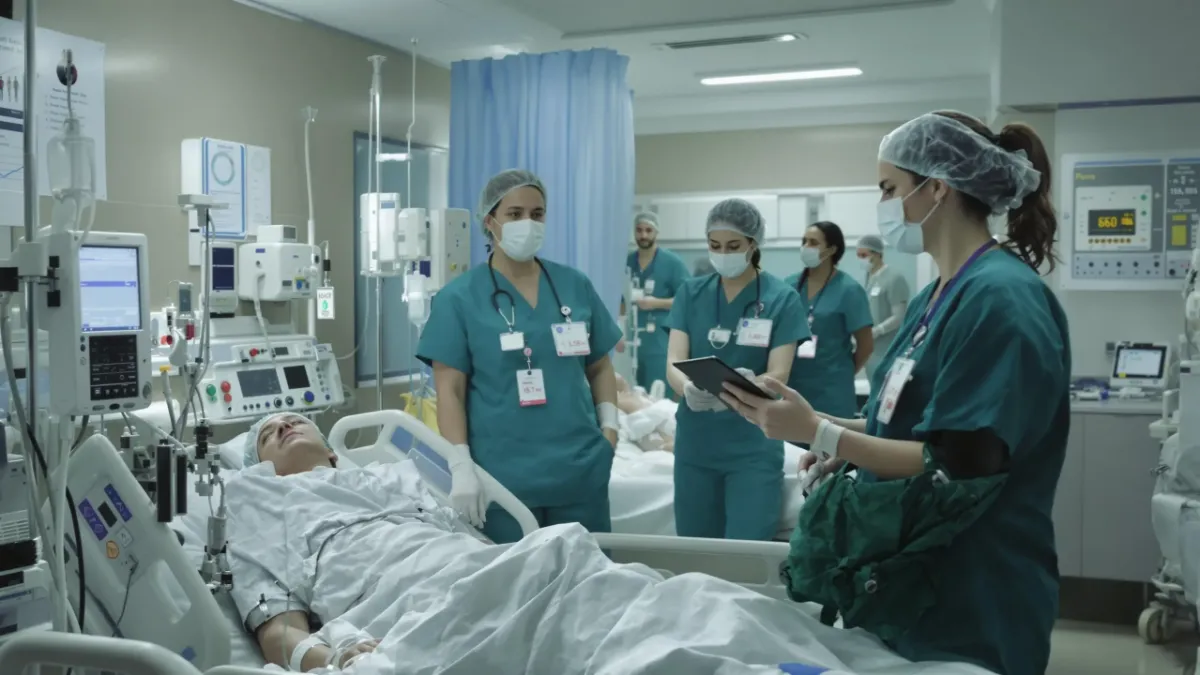Nurses on Watch: Why Vigilance Matters
Date published: April 24, 2025

Nursing vigilance is a cornerstone of patient safety, playing a vital role in preventing harm and ensuring high-quality care. The ability of nurses to remain attentive, observant, and proactive at the bedside can mean the difference between early intervention and missed warning signs. In today’s complex healthcare environment, the importance of nursing surveillance and vigilance cannot be overstated.
This article explores the causes of lapses in nursing vigilance, their impact on patients and healthcare systems, and actionable strategies to strengthen attentiveness in nursing practice.
The Scope and Impact of Nursing Vigilance
Nursing vigilance refers to the continuous process of observing, assessing, and responding to changes in a patient’s condition. Lapses in vigilance can lead to delayed recognition of clinical deterioration, medication errors, and missed opportunities for timely intervention. The consequences are significant, affecting patient outcomes, staff morale, and organizational reputation.
Key Statistics:
Research published in the American Journal of Critical Care found that increased nursing surveillance is associated with lower rates of adverse events and improved patient outcomes.
The Joint Commission identifies failure to recognize and respond to patient deterioration as a leading cause of preventable harm in hospitals.
The World Health Organization (WHO) highlights that effective nursing surveillance can reduce complications and mortality rates, especially in high-risk settings.
These findings underscore the urgent need to prioritize vigilance and attentiveness in nursing practice.
Common Causes of Lapses in Nursing Vigilance
Understanding why lapses in vigilance occur is essential for developing effective prevention strategies. Some of the most common causes include:
Inadequate Training: Lack of fundamental and ongoing education in Failure to Rescue, the recognition of the physiological and observable early warning signs a patient can demonstrate six to twenty-four hours before an unplanned cardiac arrest.
Communication Breakdowns: Incomplete handoffs, unclear documentation, and miscommunication among team members can result in missed or delayed recognition of patient needs.
Workload and Staffing: High patient-to-nurse ratios, excessive workloads, and frequent interruptions can overwhelm nurses, making it difficult to maintain constant surveillance.
Fatigue and Burnout: Long shifts, inadequate rest, and emotional exhaustion can impair a nurse’s ability to remain attentive and responsive.
System Barriers: Inefficient workflows, lack of standardized monitoring tools, and limited access to patient data can impede timely assessment and intervention.
Strategies to Strengthen Nursing Vigilance
Enhancing nursing vigilance requires a comprehensive approach involving individuals, teams, and organizations. Here are key strategies:
1. Education
· Provide initial and ongoing education on critical pillars of patient harm prevention, i.e. the significance of vital signs (respiratory rate is a key indicator), neurological changes, perfusion, fluid balance, critical laboratory data, etc.
· Encourage partnering with the rapid response team for collaboration and early interventions
2. Leveraging Technology
· Bedside Monitoring Systems: Advanced monitoring devices can provide real-time data and alerts, helping nurses detect subtle changes in patient status.
· Electronic Health Records (EHRs): EHRs facilitate quick access to patient histories, trends, and critical information, supporting informed decision-making.
3. Standardizing Surveillance Practices
· Early Warning Scores: Implementing standardized scoring systems helps nurses identify and escalate care for deteriorating patients.
· Protocols and Checklists: Structured assessment tools ensure that critical observations are not overlooked during routine care.
4. Fostering Effective Communication
· Team Huddles: Regular briefings promote information sharing and collective vigilance.
· SBAR Framework: Using structured communication tools like SBAR (Situation, Background, Assessment, Recommendation) enhances clarity and reduces misunderstandings.
5. Supporting Nurse Well-being
· Adequate Staffing: Ensuring appropriate nurse-to-patient ratios allows for thorough surveillance and timely interventions.
· Wellness Programs: Providing resources for stress management and self-care helps combat fatigue and burnout.
6. Promoting a Culture of Safety
· Encouraging Reporting: A non-punitive environment where nurses can report near misses and concerns fosters learning and improvement.
· Leadership Engagement: Visible support from leadership for patient safety initiatives reinforces the value of vigilance.
Conclusion
Nursing vigilance is not just a skill—it is a professional commitment to patient safety and quality care. By embracing technology, standardizing practices, enhancing communication, and supporting nurse well-being, healthcare organizations can empower nurses to remain ever-watchful at the bedside.
Every nurse has the power to make a difference through attentiveness and timely action. Together, we can create safer healthcare environments and build trust with the patients and families we serve.
Visit our website https://drjuliesiemers.com/lifebeat-solutions/ and book a consultation with us. For inquiries, you can also reach out via email at [email protected].
#PatientSafety #PatientCare #NurseLife #HealthcareQuality #SafeCare
Nurses on Watch: Why Vigilance Matters
Date published: April 24, 2025

Nursing vigilance is a cornerstone of patient safety, playing a vital role in preventing harm and ensuring high-quality care. The ability of nurses to remain attentive, observant, and proactive at the bedside can mean the difference between early intervention and missed warning signs. In today’s complex healthcare environment, the importance of nursing surveillance and vigilance cannot be overstated.
This article explores the causes of lapses in nursing vigilance, their impact on patients and healthcare systems, and actionable strategies to strengthen attentiveness in nursing practice.
The Scope and Impact of Nursing Vigilance
Nursing vigilance refers to the continuous process of observing, assessing, and responding to changes in a patient’s condition. Lapses in vigilance can lead to delayed recognition of clinical deterioration, medication errors, and missed opportunities for timely intervention. The consequences are significant, affecting patient outcomes, staff morale, and organizational reputation.
Key Statistics:
Research published in the American Journal of Critical Care found that increased nursing surveillance is associated with lower rates of adverse events and improved patient outcomes.
The Joint Commission identifies failure to recognize and respond to patient deterioration as a leading cause of preventable harm in hospitals.
The World Health Organization (WHO) highlights that effective nursing surveillance can reduce complications and mortality rates, especially in high-risk settings.
These findings underscore the urgent need to prioritize vigilance and attentiveness in nursing practice.
Common Causes of Lapses in Nursing Vigilance
Understanding why lapses in vigilance occur is essential for developing effective prevention strategies. Some of the most common causes include:
Inadequate Training: Lack of fundamental and ongoing education in Failure to Rescue, the recognition of the physiological and observable early warning signs a patient can demonstrate six to twenty-four hours before an unplanned cardiac arrest.
Communication Breakdowns: Incomplete handoffs, unclear documentation, and miscommunication among team members can result in missed or delayed recognition of patient needs.
Workload and Staffing: High patient-to-nurse ratios, excessive workloads, and frequent interruptions can overwhelm nurses, making it difficult to maintain constant surveillance.
Fatigue and Burnout: Long shifts, inadequate rest, and emotional exhaustion can impair a nurse’s ability to remain attentive and responsive.
System Barriers: Inefficient workflows, lack of standardized monitoring tools, and limited access to patient data can impede timely assessment and intervention.
Monitoring and Reporting
Collecting and analyzing data on safety incidents to identify trends and areas for improvement.
Establishing Standards
Developing and enforcing safety protocols to ensure consistency and quality across healthcare organizations.
Promoting Education
Providing training and resources to healthcare professionals to enhance their knowledge and skills in patient safety.
Encouraging Transparency
Creating a culture where healthcare workers feel empowered to report errors and near-misses without fear of retribution.

Driving Innovation
Leveraging technology and research to implement cutting-edge solutions for patient safety challenges.

Strategies to Strengthen Nursing Vigilance
Enhancing nursing vigilance requires a comprehensive approach involving individuals, teams, and organizations. Here are key strategies:
1. Education
· Provide initial and ongoing education on critical pillars of patient harm prevention, i.e. the significance of vital signs (respiratory rate is a key indicator), neurological changes, perfusion, fluid balance, critical laboratory data, etc.
· Encourage partnering with the rapid response team for collaboration and early interventions
2. Leveraging Technology
· Bedside Monitoring Systems: Advanced monitoring devices can provide real-time data and alerts, helping nurses detect subtle changes in patient status.
· Electronic Health Records (EHRs): EHRs facilitate quick access to patient histories, trends, and critical information, supporting informed decision-making.
3. Standardizing Surveillance Practices
· Early Warning Scores: Implementing standardized scoring systems helps nurses identify and escalate care for deteriorating patients.
· Protocols and Checklists: Structured assessment tools ensure that critical observations are not overlooked during routine care.
4. Fostering Effective Communication
· Team Huddles: Regular briefings promote information sharing and collective vigilance.
· SBAR Framework: Using structured communication tools like SBAR (Situation, Background, Assessment, Recommendation) enhances clarity and reduces misunderstandings.
5. Supporting Nurse Well-being
· Adequate Staffing: Ensuring appropriate nurse-to-patient ratios allows for thorough surveillance and timely interventions.
· Wellness Programs: Providing resources for stress management and self-care helps combat fatigue and burnout.
6. Promoting a Culture of Safety
· Encouraging Reporting: A non-punitive environment where nurses can report near misses and concerns fosters learning and improvement.
· Leadership Engagement: Visible support from leadership for patient safety initiatives reinforces the value of vigilance.
Conclusion
Nursing vigilance is not just a skill—it is a professional commitment to patient safety and quality care. By embracing technology, standardizing practices, enhancing communication, and supporting nurse well-being, healthcare organizations can empower nurses to remain ever-watchful at the bedside.
Every nurse has the power to make a difference through attentiveness and timely action. Together, we can create safer healthcare environments and build trust with the patients and families we serve.
Visit our website https://drjuliesiemers.com/lifebeat-solutions/ and book a consultation with us. For inquiries, you can also reach out via email at [email protected].
#PatientSafety #PatientCare #NurseLife #HealthcareQuality #SafeCare
